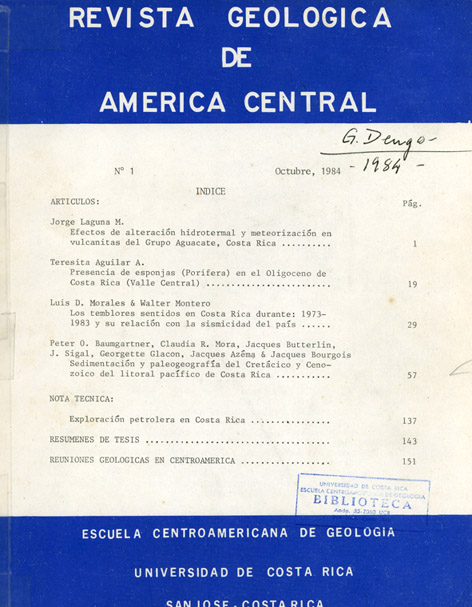Abstract
The systematic strátigraphy of the Pacific littoral of Costa Rica has been reorganized in three supergroups: 1. Papagayo: mafíc and ultramafic oceanic basements and volcanicaIly or tectonically associated sediments. 2. Garza: oceanic sedimentary cover including pelagics (Sabana Grande Group) and slope deposits (Sámara Group). 3. Mal País: neritic sedimentary cover, subdivided into 5 epochs.
A major, upper Santonian tectonic event divides the geologic history into two phases: 1. The Nicoya Complex with its Bathonian/Callovian Santonian (BAUMGARTNER 1984) oceanic sedimentary cover and the Santa Elena Peridotite form together a nappe edifíce with a southern vergence (BOURa15— et al. in press). 2. Since the Campanian, this structure is part of the stable isthmic crust, the substrate of the studied upper Senonian-Cenozoic sedimentary sequen ces, affected by open folding and normal faulting only. No accretionary struc-tures related to subduction along the Middle-American Trench, effective since ttat latest Senonian, have been observed. Ocean floor contínued te form during the latest Senonian-early Paleocene in a primitive island arc environment (Que-pos, Osa).
Campanían-middle Eocene pelagic (and background) sedimentation followed the paleooceanographic trends observed in the Pacific, amplified by local (equatorial, eastern ocean margin) hígh fertility. A shallow CCD is reflected by Santonían-lower Campanían and upper Paleocen-middle Eocene radiolarían-rich siliceous deposits. In the late Campanian-Maestrichtian a drastic drop of the CCD overruled subsidence and resulted in deposition of foramínifer-rich pelagic limestones. Thick Maestrichtian-Paleocene turbidite and mass flow sequences were deposíted in YW-SE trending elongate basins and document the erosion of an emerged andesitic volcanic are, che product of active subduction, surrounded by narrow carbonate and silicic/astio shelves, set aboye steep, unstable slopes. A tectonic event at the middleilate ocene boundary caused mayor gravitative s/iding and slumping of the upper part of the oceanic sequence, subsequent uplift and a regional, unconformable onset of shallow carbonate deposition, while turbiditc sedimentation persisted in some arcas (Santa Elena, Quepos). An inferred thickened oceanic crust in ísostatic equilibrium should form a sea floor at subphotie depths. However, tectonie uplift has repeatdly brought the substrate te shallow depth and allowed the deposítion of unconformable, thin, shortlived, neritic sequences, forffied during five succesive epochs: Epoch 1. Campanian-Maestriehtian: The structurally highest parts of the upper Santonian orogen were uplifted te subaerial and shallow photic depths where rudis-tid limestones developed. Epoch 2. Paleocene-early Encone: Voleanic activity related tu subduction gave rise tu an island are surrounded by shallow platforms NE of the study area, only known from reworked carbonate elasts in slope deposits (Sámara, Quepos). Epoch 3. Middle-late Eoeene: Tectonic uplift brought most of the area tu shallow photic depth which led tu the formation uf the widespread largor foramini-fer - red algal limestones. Epoch 4. Olígocene-early Miocene: Most of the central area was emerged and only near the trench (Nosara-Mal País) thin shallow clastic sequences developed, while turbidíte basins persisted in the NW and SE (Dept. Rivas, Nicaragua, Fila Costeña). Epoch 5. Late Miocene-Pleistocene: Littoral deposíts are concentrated around the south of Nieoya, in areas of recent uplift (FISCHER 1980).






